Historic Art Deco Storefronts Removed From Board of Education Building
The former St. Louis Board of Education Building was built in 1893, but in the late 1930s the storefront spaces on the ground floor were replaced with new Art Deco fronts. The National Register Nomination lists the period of significance for the building as 1893-1953, so these storefronts are considered historic even though they’re not original. The building is now loft apartments.
The quotes in the post are from the nomination linked above:
Overall, most of the building retains a high degree of historic integrity. The primary elevations have seen few changes and most of the exterior storefront modifications took place during the period of significance. The only other major exterior change is the loss of the pressed metal cornice, removed in 1942 during the historic period.
In March I was worried when I saw the plywood up at the entrance to the main Art Deco storefront. But perhaps it was just to protect the vitrolite and curved glass…
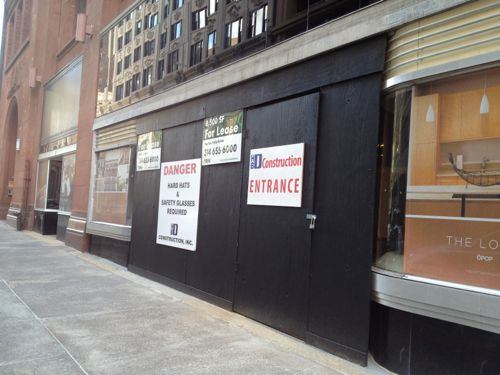
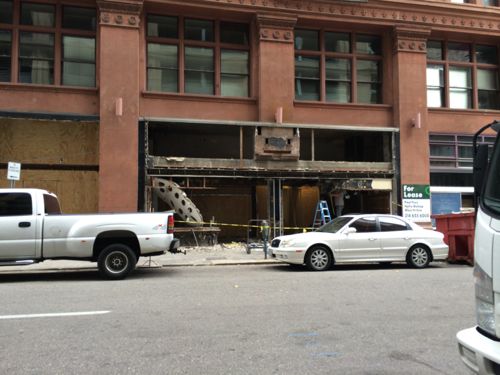
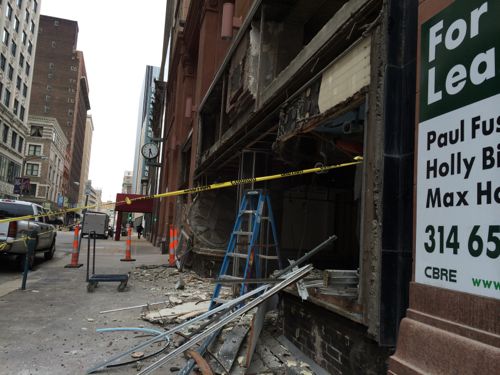
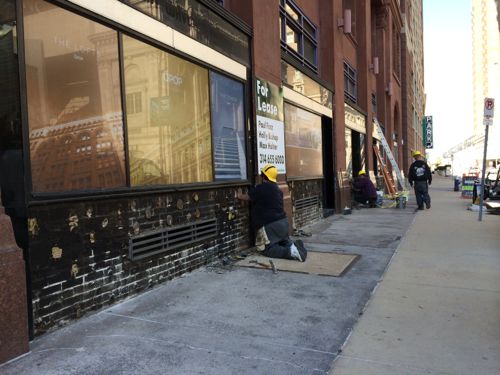
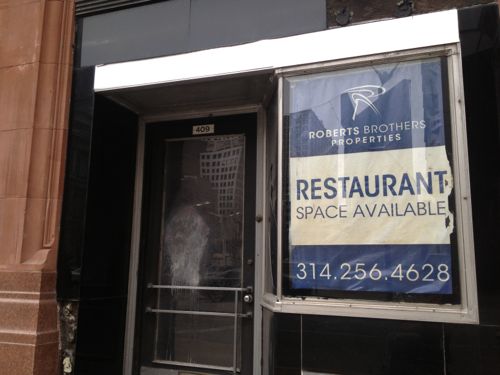
Here’s more detail on the exterior:
The remaining openings on the first floor (901-909 Locust and 401-409 North Ninth Street) are either display windows or entrances into the businesses that once occupied the first floor of this building. The original configuration of first floor openings generally alternated between display windows and recessed storefront entrances with display windows on one or both sides. Minor changes to these storefronts were noted in school board records as early as 1910. Major renovations in the 1930s transformed the original wood-framed first floor storefront entrances and display windows into distinctive examples of the Art Deco style with new Vitrolite storefronts and aluminum transom windows along the east elevation and in two bays (901, 903 Locust) on the south elevation. Art Deco modifications were completed on the 905 and 907 storefronts in 1937. An Art Deco entry, storefront and lobby was installed at 911 Locust in 1935, including a revolving door, but the revolving door was replaced in 1948 with paired glass doors within the revolving door enclosure. Additionally a single storefront was created at 905-907 Locust by removing the lower portion of the load-bearing pilaster and replacing it with a half-round, steel column. Modernization of the storefronts again took place in the 1960s, removing some of the Art Deco period features, mostly by replacing some of the doors and display window framing along Locust with the aluminum framed units seen today. The second floor windows of these bays are triple window units with fixed transoms.
The city’s Cultural Resources office attempted to get the owner to retain the storefronts but ultimately had no authority to prevent their removal. While I loved the design of these Art Deco storefronts I also knew they were an obstacle to getting tenants in the spaces. It’ll be interesting to see new storefronts in this building.
Will they be wood like the 19th Century originals or a modern design? I’d favor a modern storefront system at this point, with busy retail stores or restaurants behind them.
— Steve Patterson
Art Deco was not the original design. I just don’t get urban historics at times. They want to protect the urban setting from change, but only protect it back to the time they think it looked good, never mind what the original design was. I see it with this, with the Peveley Building, and a host of other ones.
At least the vetrolite is going to good use. The King of Vetrolite is in our backyard, seems he is a ‘national treasure’ for his work in this interesting material and as such will be using the material from this project to help restore the Hoover Dam back to it’s Original design.
The use of the “period of significance” is a valid approach, the years in which the building gained it’s historical significance. In this care, events related to use by the school board.
exactly.
Historical significance? and just how is that possible in the here and now? There are many buildings in many cities that have been destroyed to be replaced by another with supposed ‘historical significance’ with no regard to the ‘historical significance’ of the original structure. It boils down to at the time, what someone likes at that point. You just want to save buildings you like.
Exactly and we like the buildings that look good not ugly. And we will determine what looks good. Right now we like the 19th century style. We will preserve that and all European elements of our city because we like that and that is our agenda. We have money and we will fulfil our agenda. End of story. Just being honest with everyone here.
From Wikipedia: “Art Deco (/ˌɑrt ˈdɛkoʊ/), or Deco, is an influential visual arts design style which first appeared in France after World War I, flourishing internationally in the 1930s and 1940s before its popularity waned after World War II.” Sounds suspiciously like “European elements” to me!
Hate to break it to you, but you aren’t ‘everybody’. I suggest if you don’t like what is happening to the Education building, then you use YOUR money and buy it yourself. There are many that don’t like Vetrolite. It isn’t even original to the building. Period. End of Story.
Beauty is in the eye of the beholder. And in this case, the beholder with the money.
I thought the material was spelled “vitrolite”? Just saying. Now back to the conversation of 19th Century Art Deco historic preservation (eyes rolling….)
e i o, e i o. I hate typing on small boards.
I’d prefer to see a 19th century looking store-front that is wheel-chair accessible. We need to preserve St. Louis’ historical look and feel. Enough modernism.
And I’d prefer to keep the Art Deco storefronts. We need to preserve St. Louis’ historical look and feel, from its pinnacle in the 1930’s and 1940’s!
Wheel chair accessibility is (should be?) a given. Unfortunately, the most likely answer on the replacement storefronts is one that neither one of us wants to see, anodized aluminum extrusions and plate glass . . . .
Wait a couple decades. Aluminum and plate glass storefronts will be “historically significant” and protected. As will be strip malls…
We need to preserve our few examples of Art Deco way more than we need to revert another building back to a typical red brick St. Louis building – we’re never going to run out of fine examples of that genre!
http://vanishingstl.blogspot.com/2013/11/at-least-vitrolite-is-being-re-purposed.html